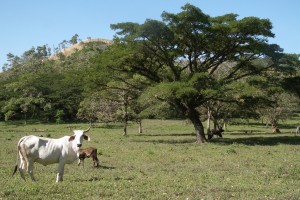 Title: Trees as drivers of silvopastoral system function in the Neotropics. SILPAS
Title: Trees as drivers of silvopastoral system function in the Neotropics. SILPAS
Funding Agency: Research Council of Norway. Env. 2015 programme Land- Grant 184065/S30
Participating organizations: Norwegian Institute for Nature Research (NINA), Centro Agronómico Tropical de Investigación y Enseñanza (CATIE)
Researchers: Pere Casals
2008-2011
The silvopastoral system is a livestock production option that involves the interaction of woody plants (shrubs and trees), herbaceous fodder plants and the different species of domestic herbivores with the aim to maximise sustainable production of animal commodities, meat, milk, wool etc. There is also an increasing amount of evidence that silvopastoral systems (multi-strata live fences and pastures with high (> 20% cover) tree densities have important conservation value. Despite these advantages, the adoption of well-functioning silvopastoral systems in the sub-humid Neotropics is limited. There is generally poor knowledge about the ecological functioning of silvopastoral systems in the sub-humid Neotropics which limits the formulation of management practices that can ensure ecological and economical sustainability at the farm and regional level, harmonising food production systems with environmental and biodiversity preservation.
Trees contribute directly to the production of silvopastoral farms through their effect on animal well-being and the supply of feed in critical periods of forage production. However, there is a need for a better understanding of how silvopastoral systems with different tree structure affects productivity of pastures around the year, and the extent to which trees contribute in buffering a reduction of production, by producing fruits and fodder.
SILPAS studies the silvopastoral system in Central America with a focus on trees as drivers of fundamental ecological processes with a bearing on the success in the adoption of the silvopastoral practice in the region. Specifically, the project will: 1. Establish the structure of silvopastoral farms (e.g. amount and type of tree cover, composition of tree and pasture species, farm and paddock size) along climate and topography gradients. 2. Assess the effects of tree cover structure and composition in interplay with livestock behaviour on spatial patterns of i) soil nutrient content, ii) the composition (species and attributes) and forage quality of the herbaceous vegetation, ii) temporal patterns of primary productivity. 3. Quantify the seasonal contribution of trees to the diet of livestock. 4. Scale up the magnitude and quality of processes at the pasture level (under 2 and 3) to the farm level according to the farm structure identified under 1. 4. Develop recommendations about silvopastoral farm tree cover.
Selected Papers:
Rusch GM, Zapata PC, Casanoves F, Casals P, Ibrahim M, DeClerk F. 2014. Determinants of grassland primary production in seasonally-dry silvopastoral systems in Central America. Agroforestry Systems 88(3), 517-526
Casals P, Romero J, Rusch G, Ibrahim M. 2014. Soil organic C and nutrient contents under trees with different functional characteristics in seasonally dry tropical silvopastures. Plant and Soil 374 (1), 643-659
Bucheli P, Benjamín T, Rusch GM, Ibrahim M, Casals P, Pugnaire F, 2013. Estrategias de los árboles en sistemas silvopastorales en el uso eficiente del agua y la tolerancia a la sequía, In Sánchez D, Villanueva C, Rusch GM, Ibrahim M, DeClerck (eds.) Estado del recurso arbóreo en fincas ganaderas y su contribución en la sostenibilidad de la producción en Rivas. Nicaragua. Pp. 25 – 30. Serie técnica. Boletín técnico/CATIE; nº60. ISBN: 978-9977-57-593-3, Turrialba, Costa Rica.
Rusch GM, Zapata P, Casals P, Romero J, Sauceda M, Morales J, DeClerck F, 2013. Relación de la cobertura arbórea con la disponibilidad de pasto , In Sánchez D, Villanueva C, Rusch GM, Ibrahim M, DeClerck (eds.) Estado del recurso arbóreo en fincas ganaderas y su contribución en la sostenibilidad de la producción en Rivas. Nicaragua. Pp. 31 – 35. Serie técnica. Boletín técnico/CATIE; nº60. ISBN: 978-9977-57-593-3, Turrialba, Costa Rica.